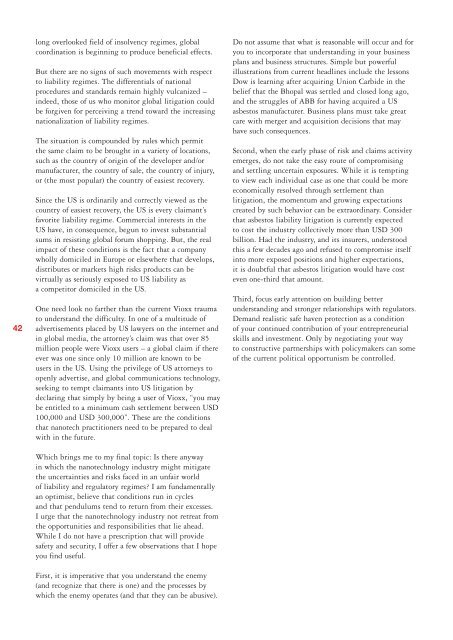Small size - large impact - Nanowerk
Small size - large impact - Nanowerk
Small size - large impact - Nanowerk
You also want an ePaper? Increase the reach of your titles
YUMPU automatically turns print PDFs into web optimized ePapers that Google loves.
42<br />
long overlooked field of insolvency regimes, global<br />
coordination is beginning to produce beneficial effects.<br />
But there are no signs of such movements with respect<br />
to liability regimes. The differentials of national<br />
procedures and standards remain highly vulcanized –<br />
indeed, those of us who monitor global litigation could<br />
be forgiven for perceiving a trend toward the increasing<br />
nationalization of liability regimes.<br />
The situation is compounded by rules which permit<br />
the same claim to be brought in a variety of locations,<br />
such as the country of origin of the developer and/or<br />
manufacturer, the country of sale, the country of injury,<br />
or (the most popular) the country of easiest recovery.<br />
Since the US is ordinarily and correctly viewed as the<br />
country of easiest recovery, the US is every claimant’s<br />
favorite liability regime. Commercial interests in the<br />
US have, in consequence, begun to invest substantial<br />
sums in resisting global forum shopping. But, the real<br />
<strong>impact</strong> of these conditions is the fact that a company<br />
wholly domiciled in Europe or elsewhere that develops,<br />
distributes or markets high risks products can be<br />
virtually as seriously exposed to US liability as<br />
a competitor domiciled in the US.<br />
One need look no farther than the current Vioxx trauma<br />
to understand the difficulty. In one of a multitude of<br />
advertisements placed by US lawyers on the internet and<br />
in global media, the attorney’s claim was that over 85<br />
million people were Vioxx users – a global claim if there<br />
ever was one since only 10 million are known to be<br />
users in the US. Using the privilege of US attorneys to<br />
openly advertise, and global communications technology,<br />
seeking to tempt claimants into US litigation by<br />
declaring that simply by being a user of Vioxx, “you may<br />
be entitled to a minimum cash settlement between USD<br />
100,000 and USD 300,000”. These are the conditions<br />
that nanotech practitioners need to be prepared to deal<br />
with in the future.<br />
Which brings me to my final topic: Is there anyway<br />
in which the nanotechnology industry might mitigate<br />
the uncertainties and risks faced in an unfair world<br />
of liability and regulatory regimes? I am fundamentally<br />
an optimist, believe that conditions run in cycles<br />
and that pendulums tend to return from their excesses.<br />
I urge that the nanotechnology industry not retreat from<br />
the opportunities and responsibilities that lie ahead.<br />
While I do not have a prescription that will provide<br />
safety and security, I offer a few observations that I hope<br />
you find useful.<br />
First, it is imperative that you understand the enemy<br />
(and recognize that there is one) and the processes by<br />
which the enemy operates (and that they can be abusive).<br />
Do not assume that what is reasonable will occur and for<br />
you to incorporate that understanding in your business<br />
plans and business structures. Simple but powerful<br />
illustrations from current headlines include the lessons<br />
Dow is learning after acquiring Union Carbide in the<br />
belief that the Bhopal was settled and closed long ago,<br />
and the struggles of ABB for having acquired a US<br />
asbestos manufacturer. Business plans must take great<br />
care with merger and acquisition decisions that may<br />
have such consequences.<br />
Second, when the early phase of risk and claims activity<br />
emerges, do not take the easy route of compromising<br />
and settling uncertain exposures. While it is tempting<br />
to view each individual case as one that could be more<br />
economically resolved through settlement than<br />
litigation, the momentum and growing expectations<br />
created by such behavior can be extraordinary. Consider<br />
that asbestos liability litigation is currently expected<br />
to cost the industry collectively more than USD 300<br />
billion. Had the industry, and its insurers, understood<br />
this a few decades ago and refused to compromise itself<br />
into more exposed positions and higher expectations,<br />
it is doubtful that asbestos litigation would have cost<br />
even one-third that amount.<br />
Third, focus early attention on building better<br />
understanding and stronger relationships with regulators.<br />
Demand realistic safe haven protection as a condition<br />
of your continued contribution of your entrepreneurial<br />
skills and investment. Only by negotiating your way<br />
to constructive partnerships with policymakers can some<br />
of the current political opportunism be controlled.
















